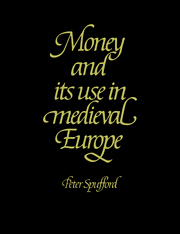Book contents
- Frontmatter
- Contents
- List of maps
- List of tables
- List of graphs
- Acknowledgements
- Introduction
- Part I Before the Commercial Revolution
- Part II The Commercial Revolution of the Thirteenth Century
- 5 New Silver c. 1160 – c. 1330
- 6 The Balance of Payments and the Movement of Silver
- 7 European Silver and African Gold
- 8 New Mints
- 9 Ingots of Silver
- 10 New Money
- 11 The Place of Money in the Commercial Revolution of the Thirteenth Century
- Part III The Late Middle Ages
- Conclusion
- Appendix I The Coins Most Commonly in Use in the Middle Ages
- Appendix II Money of Account
- Appendix III Production at Some Later Medieval Mints
- Bibliography
- Coin Index
- General Index
- Frontmatter
- Contents
- List of maps
- List of tables
- List of graphs
- Acknowledgements
- Introduction
- Part I Before the Commercial Revolution
- Part II The Commercial Revolution of the Thirteenth Century
- 5 New Silver c. 1160 – c. 1330
- 6 The Balance of Payments and the Movement of Silver
- 7 European Silver and African Gold
- 8 New Mints
- 9 Ingots of Silver
- 10 New Money
- 11 The Place of Money in the Commercial Revolution of the Thirteenth Century
- Part III The Late Middle Ages
- Conclusion
- Appendix I The Coins Most Commonly in Use in the Middle Ages
- Appendix II Money of Account
- Appendix III Production at Some Later Medieval Mints
- Bibliography
- Coin Index
- General Index
Summary
At about the same time that the expansion in the quantities of coin minted affected the nature of minting and brought about the transformation from the numerous, older, workshop mints to the few, large, newer, factory mints, there was a similar qualitative change in the nature of the money minted. The natural first stage in the expansion was to produce more of the same sorts of coins, the traditional pennies of varying types. The second stage was to produce different and larger coins. This change took place at varying dates between the early thirteenth and the mid fourteenth century depending on the economic needs of the different parts of Europe. The natural place for this stage to begin was northern Italy, not only because it was by far the most commercially advanced area of Europe, and because it was the area to which so much of the newly-available silver tended to gravitate, but also because the traditional pennies here had become much slighter in silver content than in many other parts of Europe. Whereas the prototypical denier of Charlemagne's reforms had weighed 1.7 grams, the denari of Pavia and Venice in the 1170s contained only 0.2 gram and 0.1 gram respectively. By way of contrast the English penny still contained over 1.3 grams of silver. A fairly obvious solution to the problem of the diminished silver content of the coinage was simply to attempt to replace the old denari by better, new denari.
- Type
- Chapter
- Information
- Money and its Use in Medieval Europe , pp. 225 - 239Publisher: Cambridge University PressPrint publication year: 1988
- 1
- Cited by



